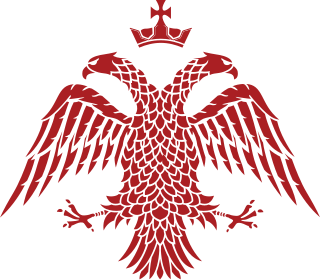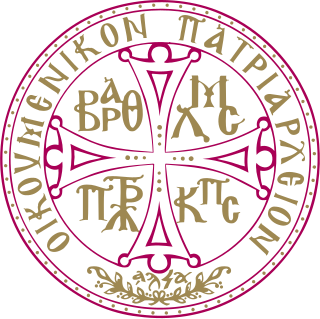
The Eastern Orthodox Church, also called the Orthodox Church and officially the Orthodox Catholic Church, is the second-largest Christian church, with approximately 220 million baptised members. It operates as a communion of autocephalous churches, each governed by its bishops via local synods. The church has no central doctrinal or governmental authority analogous to the head of the Catholic Church—the pope, although the Ecumenical Patriarch of Constantinople is recognised by them as primus inter pares. As one of the oldest surviving religious institutions in the world, the Eastern Orthodox Church has played a prominent role in the history and culture of Western Asia, the Caucasus, and Eastern and Southeastern Europe.

The Ecumenical Patriarchate of Constantinople is one of the fifteen to seventeen autocephalous churches that together compose the Eastern Orthodox Church. It is headed by the Ecumenical Patriarch of Constantinople.

The Greek Orthodox Patriarchate of Antioch, also known as the Antiochian Orthodox Church and legally as the RūmOrthodox Patriarchate of Antioch and All the East, is an autocephalous Greek Orthodox church within the wider communion of Eastern Orthodox Christianity and one of the historic Pentarchy. Headed by the Greek Orthodox patriarch of Antioch, it considers itself the successor to the Christian community founded in Antioch by the Apostles Peter and Paul. It is one of the largest Christian denominations of the Middle East, alongside the Copts of Egypt and the Maronites of Lebanon.

The Church of Greece, part of the wider Greek Orthodox Church, is one of the autocephalous churches which make up the communion of Eastern Orthodox Christianity. Its canonical territory is confined to the borders of Greece prior to the Balkan Wars of 1912–1913, with the rest of Greece being subject to the jurisdiction of the Ecumenical Patriarchate of Constantinople. However, most of the dioceses of the Metropolises of the New Lands are de facto administered as part of the Church of Greece for practical reasons, under an agreement between the churches of Athens and Constantinople. The primate of the Church of Greece is the archbishop of Athens and All Greece.

The Greek Orthodox Patriarchate of Jerusalem, also known as the Greek Orthodox Church of Jerusalem, is an autocephalous church within the wider communion of Eastern Orthodox Christianity. Established in the mid-fifth century as one of the oldest patriarchates in Christendom, it is headquartered in the Church of the Holy Sepulchre in Jerusalem and led by the Patriarch of Jerusalem, currently Theophilos III. The Patriarchate's ecclesiastical jurisdiction includes roughly 200,000 to 500,000 Orthodox Christians across the Holy Land in Palestine, Jordan and Israel.

Germanos Karavangelis was known for his service as Metropolitan Bishop of Kastoria and later Amaseia, Pontus. He was a member of the Hellenic Macedonian Committee and functioned as one of the major coordinators of the Greek Struggle for Macedonia.

The Ukrainian Orthodox Church – Kyiv Patriarchate is an unrecognized Orthodox church in Ukraine. It came into existence in 1992.
The archiepiscopal see of Caesarea in Palaestina, also known as Caesarea Maritima, is now a metropolitan see of the Eastern Orthodox Patriarchate of Jerusalem and also a titular see of the Catholic Church. It was one of the earliest Christian bishoprics, and was a metropolitan see at the time of the First Council of Nicaea, but was later subjected to the Patriarchate of Jerusalem. The city remained largely Christian until the Crusades, its bishop maintaining close ties to the Byzantine Empire. After the establishment of the Kingdom of Jerusalem by the crusaders, the see was transformed into a Latin archdiocese, subordinate to the Latin patriarch of Jerusalem.
The Halki seminary, formally the Theological School of Halki, was founded on 1 October 1844 on the island of Halki, the second-largest of the Princes' Islands in the Sea of Marmara. It was the main school of theology of the Eastern Orthodox Church's Ecumenical Patriarchate of Constantinople until the Turkish parliament enacted a law banning private higher education institutions in 1971. The theological school is located at the top of the island's Hill of Hope, on the site of the Byzantine-era Monastery of the Holy Trinity. The premises of the school continue to be maintained by the monastery and are used to host conferences. It is possible to visit the island where it is located via boat in approximately one hour from the shore of Istanbul. An international campaign to reopen this theological school is ongoing.

The Patriarchate of Aquileia was an episcopal see and ecclesiastical province in northeastern Italy, originally centered in the ancient city of Aquileia, situated near the northern coast of the Adriatic Sea. It emerged in the 4th century as a metropolitan province, with jurisdiction over the Italian region of Venetia et Histria. In the second half of the 6th century, metropolitan bishops of Aquileia started to use the patriarchal title. Their residence was moved to Grado in 568, after the Lombard conquest of Aquileia. In 606, an internal schism occurred, and since that time there were two rival lines of Aquileian patriarchs: one in New Aquileia (Grado) with jurisdiction over the Byzantine-controlled coastal regions, and the other in Old Aquileia. The first line (Grado) continued until 1451, while the second line continued until 1751. Patriarchs of the second line were also feudal lords of the Patriarchal State of Aquileia. A number of Aquileian church councils were held during the late antiquity and throughout the middle ages. Today, it is an titular archiepiscopal see.
Antonio De Rosso was an Italian priest and Christian leader who successively belonged to various Christian denominations. After initial priestly service in the Catholic Church, he changed several affiliations. Eventually, he became Eastern Orthodox bishop (1986), founder of the Orthodox Church in Italy (1991), Metropolitan of Ravenna and Italy (1997-2009), and Archbishop of L'Aquila (2009).

Hilarion is a bishop of the Russian Orthodox Church and the current metropolitan of Budapest and Hungary. He is also a noted theologian, church historian and composer and has published books on dogmatic theology, patristics and church history as well as numerous compositions for choir and orchestra.
The Exarchate of the Philippines is an exarchate or sub-diocesan entity of the Eastern Orthodox Metropolis of Hong Kong and Southeast Asia that is located in the Philippines. The metropolis is one of four metropolises in Asia that are under the jurisdiction of the Ecumenical Patriarchate of Constantinople. The exarchate has five parishes and three chapels in the country.

Cyril V Karakallos, was Ecumenical Patriarch of Constantinople for two periods from 1748 to 1751 and from 1752 to 1757.
The Metropolis of Ephesus was an ecclesiastical territory (metropolis) of the Ecumenical Patriarchate of Constantinople in western Asia Minor, modern Turkey. Christianity was introduced already in the city of Ephesus in the 1st century AD by Paul the Apostle. The local Christian community comprised one of the seven churches of Asia mentioned at the Book of Revelation, written by John the Apostle. The metropolis remained active until 1922-1923.

The Pan-Orthodox Council, officially referred to as the Holy and Great Council of the Orthodox Church, was a synod of set representative bishops of the universally recognised autocephalous local churches of the Eastern Orthodox Church held in Kolymvari, Crete. The Council sat from 19 to 26 June 2016.
The Metropolis of Singapore and South Asia is a diocese of the Ecumenical Patriarchate of Constantinople in the Eastern Orthodox Church. It is centered in Singapore and has jurisdiction over Eastern Orthodox Christians in the countries of Singapore, Indonesia, Malaysia, Brunei, East Timor, the Maldives, Sri Lanka, Bangladesh, India, Nepal, Bhutan, Pakistan and Afghanistan. It was founded in January 2008 by the Holy Synod of the Ecumenical Patriarchate of Constantinople.

A schism between the Russian Orthodox Church and the Ecumenical Patriarchate of Constantinople began on 15 October 2018 when the former unilaterally severed full communion with the latter.
On 15 October 2018, the Russian Orthodox Church broke the communion with the Ecumenical Patriarchate because of a dispute concerning the canonical jurisdiction over Ukraine. This led to the 2018 Moscow–Constantinople schism. Numerous Orthodox churches took position concerning the dispute over the canonical jurisdiction over Ukraine, whether before or after this schism.
The schism between the Ecumenical Patriarchate and part ofitsMetropolis of Kiev and all Rus occurred between approximately 1467 and 1560. This schism de facto ended supposedly around 1560.














